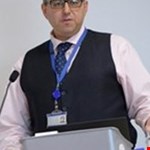Thermally Assisted Piercing of Acoustic Liners (TAPACO)
Background
Aircraft engines contribute significantly to noise pollution (Jones, 2014). An increase in air travel has increased the demand for quieter aircraft. Intake acoustic liners encase large turbofan aircraft engines and attenuate their noise. Kempton (2011) identified the lightweight of acoustic liners as one of the major challenges. The best-performing broadband absorbing liner configuration is a sandwich structure with a perforated facing sheet (see Figure 1) exposed to the air stream and a specially designed cell structure. The perforation pattern and the design of the sandwich cell are of chief importance to the acoustic behaviour of the liner. Composites can offer significant weight reductions due to their anisotropic properties and low-density constituents.
State-of-the-art liners are mainly made of thermoset composites and the perforation is done by orbital drilling or robotic laser heads. However, both methods lead to cutting of the load-bearing fibres which results in a reduction of the composite efficiency. This forces the designer to add more material to the design which reduces the potential fuel savings. Perforating without cutting fibres could be a key approach to maximising noise reduction without compromising on weight savings. In addition, both drilling and laser drilling can create localised heat areas that damage the composite material. Furthermore, Thermoset matrix composites are used extensively in various industries including aerospace. The application of thermoplastic matrix materials, however, has not currently reached the same levels of development as those attained with thermosets. Thermoplastic materials have clear advantages in comparison to the thermoset matrix composites such as the capability to be recycled and welded. The weldability of thermoplastic can eliminate the need for bonding and riveting and the cost and weight issues associated with each of these. Table 1 presents a comparison between thermoset and thermoplastic resin properties.
 Table 1: Characteristic properties of thermoset and thermoplastic resins
Table 1: Characteristic properties of thermoset and thermoplastic resins
Objective
The project will address the challenge of producing cost effectively acoustic liners and their key component the perforated sheet made of thermoplastic composites.
The TAPACO solution focuses on the use of the Thermally Assisted Piercing (TAP) technique in order to perforate the acoustic liners on the jet engine. TAPACO, a concept developed by Brunel Composites Centre, will enable the perforation of a one-piece acoustic liner without the need for drilling. Thermally Assisted Piercing (TAP), is a material displacement technique that has been used previously to create holes in composite materials without damaging the load-bearing fibres. In this technique, the thermoplastic composite material is heated which allows the movement of the fibres in the molten matrix. The TAP rig can then be pressed onto the composite material in order to displace the load-bearing fibres and create a hole pattern according to acoustic design specifications. The process will be automated and continuous piercing of the facing sheet liner is possible.
 An exemplary turbofan gas turbine engine, with an acoustic liner (22) disposed on the radially inner surface of the fan duct
An exemplary turbofan gas turbine engine, with an acoustic liner (22) disposed on the radially inner surface of the fan duct
Benefits
The proposed technology will eliminate the main disadvantage of current state-of-the-art perforation methods which is the cutting of the load-bearing fibres while performing the drilling operation. This technology will allow the user to utilise the capability of thermoplastics to melt and reshape upon heating to their processing temperature which in case of engineering thermoplastics is well above the expected service temperature. In addition, thermoplastic composites are tougher and more damage tolerant than thermosets and are easier to repair and can be shaped using simpler equipment. For the manufacturing of acoustic liners more than 50% of the cost is attributed to shaping and drilling and with material cost being similar between high-performance epoxies and suitable engineering thermoplastics we expect a cost reduction of 15 to 20% for TAPACO technology. The methodology can be tailored to account for different geometries is scalable and can be automated. Other important advantages are the use of non-complex equipment, the short processing time, the simple operation principle, and the elimination of hazardous by-products such as dust or fumes.
Brunel Composites Centre is involved technically by offering expertise in the TAP technology and leading the finite element modelling, future planning, dissemination, and exploitation work packages of TAPACO.
Project Partners
- Denroy
- Spirit AeroSystems
- Involute Engineering
- Brunel Composites Centre
Meet the Principal Investigator(s) for the project

Dr Mihalis Kazilas - Dr Mihalis Kazilas is the Director of the Brunel Composites Centre. He has more than 20 years of experience in the composites processing area. He received his PhD in Advanced Materials from Cranfield University back in 2003. His main field of expertise are polymers characterisation and polymer composites manufacturing and joining processes. He is author of several refereed scientific publications in the area of advanced composites manufacturing and process optimisation. Mihalis is a creative thinker who enjoys problem solving and able to work with different stakeholders to achieve the optimum results in both technical and managerial environments.
Work experience:
Sep 2019 – present: Business Group Manager, Polymer and Composite Technologies, TWI, UK
June 2019 – present: Director of the Non-Metallics Innovation Centre, a joint initiative between TWI, Saudi Aramco and ADNOC
Oct 2016 – present: Centre Director, Brunel Composites Innovation Centre, Brunel University London, UK
Feb 2012 – 2019: Section Manager, Adhesives, Composites and Sealants (ACS) section within the Joining Process Group at TWI, UK
May 2006 – Jan 2012: R&D Consultant, Project Engineer, Collaborative Projects Operations Manager at INASCO, Greece
Related Research Group(s)
Brunel Composites Centre - Shared research and technology capabilities, specialising in novel composites processing and joining technologies applied to industrial environments.
Brunel Innovation Centre - A world-class research and technology centre that sits between the knowledge base and industry.
Partnering with confidence
Organisations interested in our research can partner with us with confidence backed by an external and independent benchmark: The Knowledge Exchange Framework. Read more.
Project last modified 22/02/2023